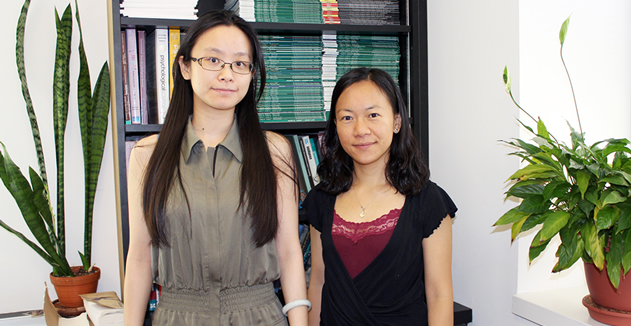Columbia University
Irving Medical Center
Neurological Institute
710 West 168th Street, 3rd floor
(212) 305-1818
Featured Research
IN THE LAB:
Christian Habeck, PhD
 Christian Habeck, PhD
Christian Habeck, PhDThe brain operates as a network. This self-evident notion was, until less than a decade ago, not routinely taken into account in the analysis of brain imaging data collected for cognitive and clinical neuroscience research. Since then there has been a methodological turn, and network analysis has become a mainstay of neuroimaging, arguably sometimes with too much focus on the methods themselves to the detriment of good research questions or sufficient robustness of the developed tools.
Our lab, the Brain Networks Laboratory, builds on the innovative network-analytic techniques for brain imaging that were pioneered by James Moeller here at Columbia University in the 1980s (Moeller et al. 1987), long before network-analytic techniques started to enjoy their current popularity. We apply and refine these methods, while keeping them as simple as possible and in the service of important neuroscientific research questions, not as ends in and of themselves.
We develop and apply network-analysis approaches based on multivariate techniques for clinical and basic cognitive neuroscience, giving special emphasis to non-parametric statistical approaches for assessing robustness and replication. Replication of brain-behavioral associations is a central feature of our brand of network analysis: for instance, multivariate activation patterns derived from a cognitive neuroimaging experiment that are associated with a behavioral outcome should, ideally, also be associated with the same outcome in an independent replication of the same experiment. For diagnostic applications, this tenet of replication is even more pronounced: a neuroimaging-based disease marker should diagnose a disease with good predictive value beyond the data sample it was derived from.
Figures 1 and 2 show recent examples of network analyses from our lab for cognitive and diagnostic neuroscience, respectively.
 Figure 1: A network derived as a functional-MRI activation pattern from two cognitive tasks that were scanned in the fMRI scanner. For a test of validity, the pattern score, a single number quantifying the degree of pattern manifestation for each participant, was correlated with reaction time in a working-memory experiment (top left): participants with better network manifestation had lower reaction times, i.e. better performance. Further, participants with better network manifestation also possessed higher verbal IQ scores (top right). The topographic composition of the network is shown in the lower panel. Pattern loadings with sufficient robustness (|Z|>2) are depicted and explain the directionality of activation associated with the activation pattern. Red loadings indicate increasing functional activation with better behavioral performance and higher verbal IQ. Blue loadings indicate decreasing functional activation.
|
 Figure 2: Multivariate analysis was applied to FDG-PET scans of 25 healthy elderly controls (Normal), 74 people with Mild Cognitive Impairment (MCI), and 108 patients with Early Alzheimer' Disease (AD). (Data courtesy of Technical University, Munich, Germany.) Left: pattern scores are plotted as a function of disease status. Right: topographic composition of the disease-related pattern; only robust loadings are shown (|Z|>3). The red areas indicate relative preservation of FDG-PET signal, while the blue areas reproduce the canonical parietotemporal metabolic deficit typically observed for AD.
|
Future work of our lab will apply multivariate analytic techniques to several imaging modalities in parallel. For instance, simultaneously analyzing functional and structural MRI to derive structural-functional patterns that can more parsimoniously describe normal and abnormal cognitive aging, and give both mechanistic insights into the cognitive-aging process, while providing predictive information about an individual's future trajectory. Main data sources within the Taub Institute come from the Washington Heights–Inwood Community Aging Project (WHICAP), and the Reference Ability Neural Network (RANN) study and Cognitive Reserve study, both in the Cognitive Neuroscience of Aging Laboratory, led by Dr. Yaakov Stern.
 Members of the Habeck Laboratory include, from left to right, Dan Liu and Yunglin Gazes.
|
Lab members include Dr. Yunglin Gazes, PhD, who specializes in white-matter integrity measures and their relation to functional activation, and Dan Liu, MS, who performs image pre-processing, data-basing, computer programming and quality control for the brain images. Dr. Gazes has applied our network analysis tool on functional activation for executive control task and found association between pattern score and performance on executive function. Her current project examines the relationships among aging, functional activation, white matter integrity, and cognitive performance.
We have several collaborators within the Taub Institute and CUMC at large who regularly provide interesting data and research questions for an exciting multidisciplinary dialogue: Dr. Yaakov Stern, PhD, with whom we work on deriving functional MRI pattern underlying Cognitive Reserve and the major reference abilities of Episodic Memory, Fluid Reasoning, Speed of Attention, and Vocabulary; Dr. Ray Razlighi who advises us on matters of high-quality structural brain data; Dr. Hwamee Oh, PhD, with whom we have derived FDG-PET and cortical thickness patterns that are associated with overall amyloid deposition in the brain; Drs. Edward Huey, MD, and Stephanie Cosentino, PhD, with whom we work on deriving cerebral blood-flow patterns of FTD-gene carriers; Drs. Joanna Steinglass, MD, and Jonathan Posner, MD, both in Psychiatry with whom we work on deriving similar patterns in regard to ADHD and Anorexia Nervosa; Dr. Marla Hamberger, PhD, with whom we work on identifying fMRI-activation patterns underlying auditory and verbal naming; Dr. Sandra Barral, PhD, to whom we provide network phenotypes and who helps us with gene-behavior associational analysis; and Dr. James Moeller, PhD, Psychiatry, who has been a long-time collaborator regarding the theoretical development work of our network techniques. Beyond CUMC, we have collaborators that have used our techniques for cognitive aging (Dr. William Jagust, MD, UC Berkeley; Dr. Jeanyung Chey, PhD, National University of Korea, Seoul, South Korea), as well as Parkinson's and Huntington's Disease (Dr. David Eidelberg, MD, Dr. Chris Tang, MD, PhD, both at North Shore Hospital; Dr. Sean Colloby, PhD, University of Newcastle, UK).

